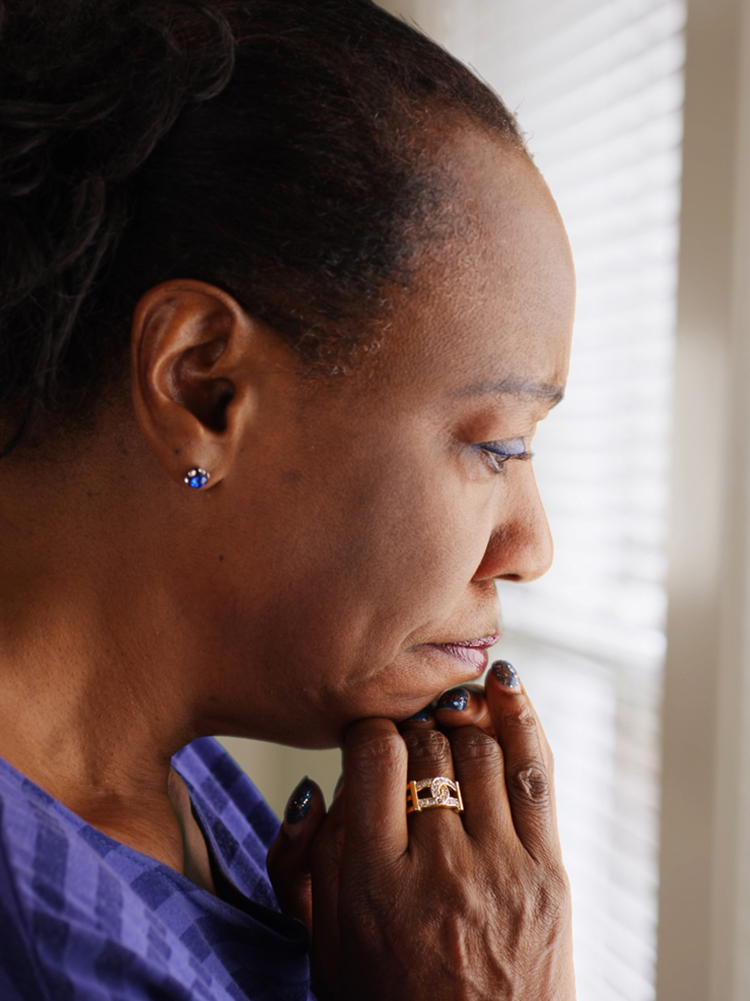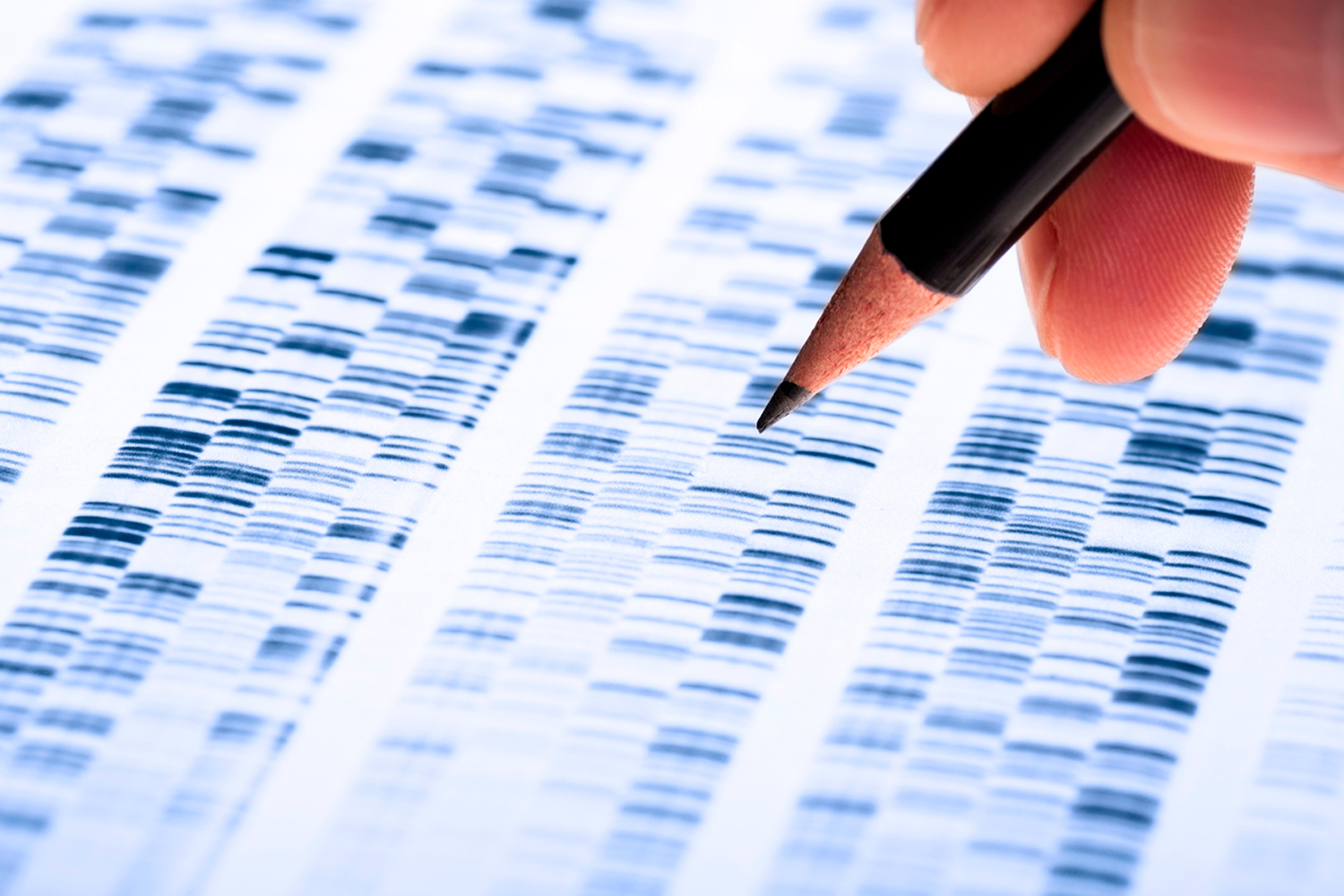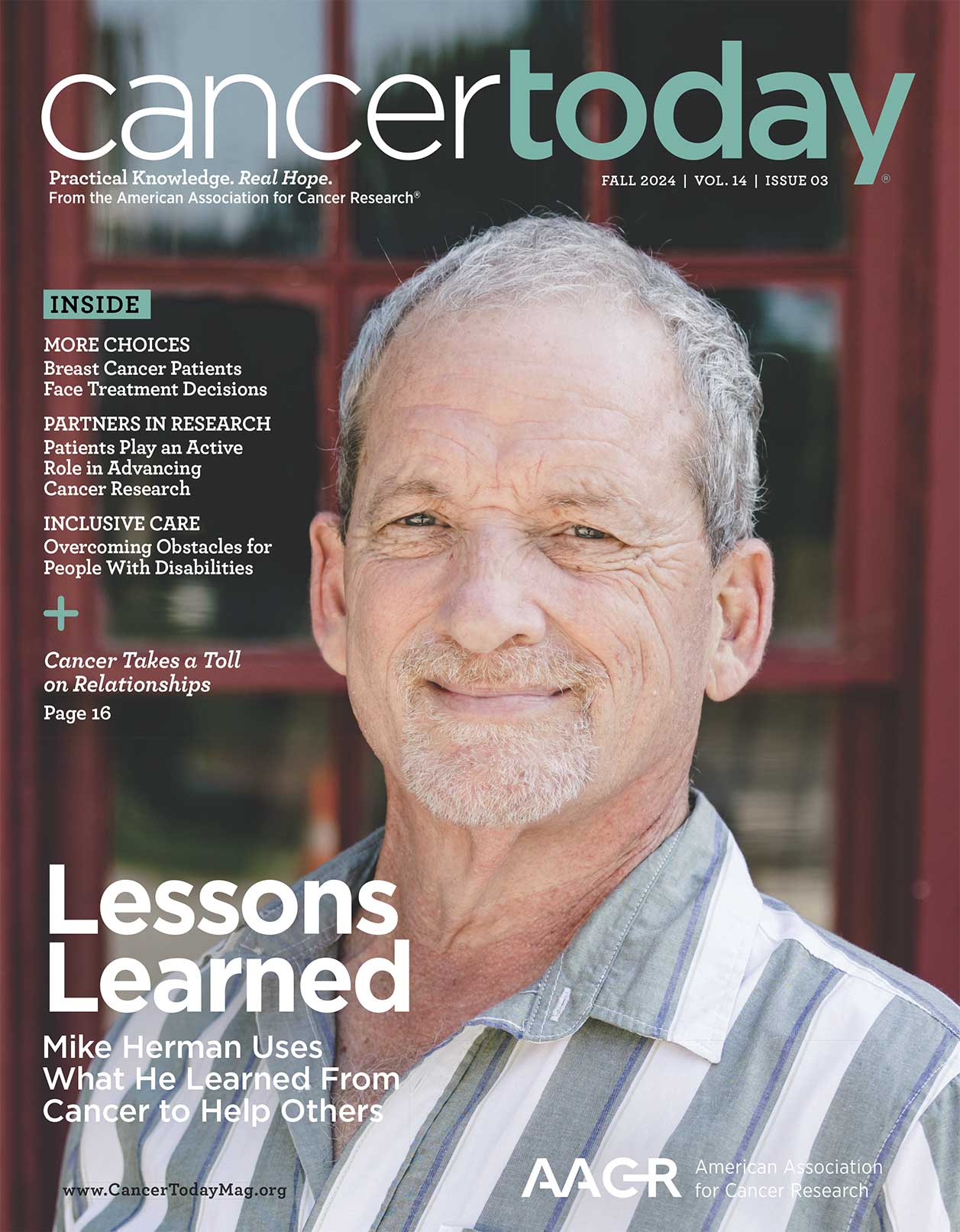WHEN KATE HOVDE OF PHILADELPHIA WAS DIAGNOSED WITH STAGE I INVASIVE BREAST CANCER in fall 2021, all signs pointed in a positive direction after her lumpectomy. The tumor was limited to her breast and smaller than her surgeon had expected. It didn’t look aggressive, and it was estrogen receptor-positive (ER-positive), meaning she could take hormonal therapy to lower the risk of recurrence. Hormonal therapies either lower the amount of estrogen in the body or block its effect on cancer cells. Hovde, 61, enjoys walking and hiking, so she was eager to avoid chemotherapy because of side effects such as neuropathy, which causes nerve pain or numbness in the hands and feet.
Then life threw Hovde another curveball: Her Oncotype DX Recurrence Score was 27. Treatment guidelines generally advise people with early-stage, ER-positive invasive breast cancer in the 26 to 100 score range to undergo chemotherapy, given a relatively higher risk of distant cancer recurrence than women with scores of 25 or lower.
“I was at the low end of the high-risk range, and everything I read said I was in a gray area,” Hovde says. “My oncologist could see an argument for doing chemotherapy or not doing it. You have to make a decision, but that doesn’t make it easy.”
Tailoring Decisions About Chemotherapy
Oncotype DX is a genomic test performed on the tumor tissue after surgery to analyze the activity of 21 genes—16 cancer-related genes and five reference genes—that can influence how likely the cancer is to come back somewhere else in the body.
The gene analysis generates a Recurrence Score that is used to estimate the percentage risk of distant recurrence within nine years for people whose cancer has not spread to the lymph nodes if a person takes five years of hormonal therapy after surgery. It also predicts the degree of risk reduction if chemotherapy is added to the treatment regimen. All three numbers—Recurrence Score, risk of recurrence and average degree of risk reduction from chemotherapy for people in certain score ranges (such as 0-10, 11-25 and 26-100)—appear in the report, along with detailed graphs to help a woman understand the chemotherapy benefit associated with her specific Recurrence Score. Women with early-stage, ER-positive breast cancer are eligible for testing; those with HER2-positive breast cancer, a more aggressive type, are not. For these women, chemotherapy is a standard part of treatment.
Zonera A. Ali, a medical oncologist who specializes in breast cancer, will never forget when Oncotype DX came out in 2004. “It was just so transforming for how we practice,” said Ali, who practices at Lankenau Medical Center in Wynnewood, Pennsylvania, part of Main Line Health. “We gave more chemotherapy before, because we thought that the risk of recurrence was high if the tumor was larger than 1 centimeter or high-grade. But when we started ordering Oncotype for all node-negative women [women whose cancer has not spread to the lymph nodes], it really changed how we treated many of them.”
“It decreased the use of chemotherapy,” says medical oncologist Norah Lynn Henry, breast oncology disease lead at the University of Michigan’s Rogel Cancer Center in Ann Arbor. “We probably were overtreating in the past, and we’re not doing that anymore, which is a good thing.” Henry served on the panel that authored Biomarkers for Adjuvant Endocrine and Chemotherapy in Early-Stage Breast Cancer: ASCO Guideline Update, released by the American Society of Clinical Oncology (ASCO) in 2022. The panel reviewed studies published between 2016 and 2021 on Oncotype DX and other genomic tests, including Mammaprint, Prosigna and Endo Predict. Oncotype DX is the most commonly used test in the U.S. and was the first test to not only assess the risk of late distant recurrence but also predict the benefit of using chemotherapy with hormonal therapy. The guideline update gave its strongest recommendation to Oncotype DX, further noting that it is the only test that should be used in premenopausal women.

Photo by Rocketclips, Inc. / Shutterstock.com
Since Oncotype DX’s debut, researchers have been working to better define how its results should guide treatment planning in breast cancer. Current recommendations are based largely on the results of the TAILORx (Trial Assigning Individualized Options for Treatment) clinical trial, which used Oncotype DX Recurrence Scores to guide treatment for more than 10,000 women with early-stage, hormone receptor-positive breast cancer that had not spread to the lymph nodes. Women with low-risk Recurrence Scores from 0 to 10 received hormonal therapy alone, while those scoring 26 or higher received both hormonal therapy and chemotherapy. Women with intermediate scores of 11 to 25 were randomly assigned to receive either hormonal therapy alone or chemotherapy plus hormonal therapy.
The study, published in 2018, found that for women with a Recurrence Score of 11 to 25, chemotherapy did not significantly lower their risk of distant or regional recurrence or increase their survival. For women with a Recurrence Score of 26 to 100, like Kate Hovde, the study found that chemotherapy should be considered, with the greatest benefit for those with scores of 30 or higher.
“I remember my oncologist taking me through the TAILORx charts and explaining that chemotherapy could increase the chance I would remain free of distant recurrence by about four percentage points—a benefit, but not a big benefit,” Hovde says. “If the score had been 30 or 35, it would have been a no-brainer, and we probably wouldn’t have thought twice.” She sought advice from the advocacy organization Living Beyond Breast Cancer, and a contact there helped her find an oncologist for a second opinion.
“Ultimately, I decided I would like to have the best odds possible,” Hovde says. “Of course, people tolerate risk differently, and if I had been older, say 75, with other health conditions, I might have decided that chemo wasn’t worth it.” Hovde completed four rounds of chemotherapy and is now taking an aromatase inhibitor to lower estrogen levels.
Having conversations with patients to identify their priorities and needs is key, notes Pallav Mehta, a medical oncologist with MD Anderson Cancer Center at Cooper in Camden, New Jersey. “Statistics are not about individuals but based on populations,” he says. “Every patient is different in terms of age, medical history, how they think about these things. Some individuals say that, even for a low benefit, ‘I want to take everything.’ Others are more like, ‘I am good. Even if it’s a little bit of Russian roulette, I am OK doing less.’”
For patients who fall into a gray area, Mehta sometimes uses an online tool called RSClin, which combines the Oncotype DX score with information such as the tumor size and grade and a patient’s age to further individualize the predicted risk of the cancer recurring in another part of the body in 10 years.
Mehta notes that a high Oncotype DX score can sometimes convince a reluctant patient that adding chemotherapy is the right course of action. “No one ever wants chemo, but the test can provide ammunition to say, ‘Here’s why you need it,’” he says. “Once you have a score in the 30s, you are approaching a 1 in 5 risk of distant recurrence without chemotherapy. Breast cancer that spreads is what kills women, and if that chance is high enough, the question is then, ‘What do we need to do to lower that chance?’”
Tougher Choices for Premenopausal Women
Although an Oncotype DX score under 26 is considered lower risk, the new ASCO guideline update states that doctors can offer chemotherapy to women 50 or younger with a score in the 16 to 25 range. That’s because TAILORx showed some benefit in combining chemotherapy with hormonal therapy in this age group. At nine years of follow-up, 93.4% of women 50 or younger with a score of 21 to 25 who took both treatments remained free of distant recurrence, versus 86.9% of those doing hormonal therapy alone—a difference of 6.5 percentage points. The gain was smaller for women with scores in the 16 to 20 range, about 1.5 percentage points—meaning the decision to have chemotherapy may not be as straightforward for women in the lower score range.
When Dilara Bogut of Washington, D.C., was diagnosed in 2021 with early-stage, ER-positive breast cancer at age 31, her Oncotype DX score was 23—which she says was “high enough” for her doctor to recommend chemotherapy.
“I was kind of relieved about getting chemotherapy, because I didn’t really want to have to go through this again,” Bogut says. “All of these things come down to risk tolerance, and for me personally, I did not want to gamble.
“Of course, the risk will never be zero,” she says. “But my report said I would have a 9% chance of distant recurrence with hormonal therapy alone versus less than 1% if I added chemotherapy.” Bogut finished four rounds of chemotherapy in May 2022. She is now taking Zoladex (goserelin), a monthly hormonal therapy injection that stops the ovaries from producing estrogen, and an aromatase inhibitor.
“After conversations with my oncologist and other doctors, I decided to not have the full six rounds and stop at four,” she says, due to both the side effects and time commitment. “I wish the score could have told me the benefit of four rounds versus six, but maybe that research will be there someday.” Oncotype DX scores can’t be used to make decisions about the length of chemotherapy treatment or which medicines to give, although doctors may feel some reassurance treating lower-scoring cancers with less aggressive regimens, Mehta says.
What’s also not clear is whether the apparent benefit of chemotherapy for some younger women in TAILORx was due to the medicines themselves or to the fact that “chemotherapy also suppresses ovarian function,” notes Ali of Lankenau Medical Center. Chemotherapy often leads to temporary or permanent menopause in premenopausal women. “This is an important future direction for research,” she adds.
Testing When Cancer Is in the Lymph Nodes
Perhaps the most significant new recommendation found in the ASCO guideline update is that Oncotype DX can be used in postmenopausal women whose breast cancer has spread to one to three lymph nodes—allowing women with low scores to forgo chemotherapy. Previously, the test wasn’t recommended for node-positive women.
A study published in the Dec. 16, 2021, New England Journal of Medicine called RxPONDER (Rx for Positive Node, Endocrine Responsive Breast Cancer) looked at the benefit of using chemotherapy in addition to hormonal therapy—also called endocrine therapy—for node-positive women. For postmenopausal women with an Oncotype DX score of 25 or lower, roughly 91% were alive and free of disease at five years, whether or not they had chemotherapy in addition to hormonal therapy. For premenopausal women with a score of 25 or lower, though, 89% of those who received hormonal therapy alone and 93.9% of those who added chemotherapy were alive and disease-free after five years, suggesting benefit from chemotherapy.
“I just saw a patient in her early 50s with a high-grade cancer that was strongly positive for estrogen and progesterone receptors and had three involved lymph nodes,” says Henry of the Rogel Cancer Center in Michigan. “In the past, I would have automatically said, ‘We’re going to have to give you chemo.’ Instead, I ordered Oncotype to learn more about the biology of the tumor to help make that decision [whether or not to give chemotherapy].”
Henry adds that trials such as RxPONDER and TAILORx have “removed a lot of questions” for postmenopausal women, but questions remain for premenopausal women with lymph node involvement, for whom chemotherapy is still recommended. “I would say the premenopausal patient with lymph node involvement is the most challenging clinical scenario for us at this time,” Henry says.
Making Decisions About Extending Hormonal Therapy
In addition to the question of whether to add chemotherapy to hormonal therapy, women with early-stage, ER-positive breast cancer often struggle with the length of hormonal therapy. It can be taken for five to 10 years, depending on whether the features of the cancer suggest it’s low risk or high risk. Lack of full compliance with hormonal therapy is common, given side effects such as joint pain, bone thinning, hot flashes and mood swings.
Although some clinical trials have shown that extending hormonal therapy beyond five years can reduce the risk of recurrence, it’s unclear whether this makes sense for every woman in every situation.
How genomic tests can be used to guide treatment for some people with breast cancer.
For women with early-stage, ER-positive, HER2-negative breast cancer making decisions about hormonal therapy and chemotherapy:
- Oncotype DX is the only test recommended for premenopausal women and should only be used for those with no lymph node involvement.
- Oncotype DX is recommended for postmenopausal women with up to three lymph nodes involved. Other options include Mammaprint, EndoPredict, Prosigna and Ki67 testing (a measure of how rapidly the cells are growing).
- Recurrence Score equal to or greater than 26: Chemotherapy and hormonal therapy should be offered.
- Recurrence Score 16-25 in women age 50 or younger: Adding chemotherapy to hormonal therapy can be considered.
A genomic test known as Breast Cancer Index (BCI) can now be used to guide decisions about extending hormonal therapy from five years to 10. The BCI test uses breast cancer tissue from the original biopsy to analyze the activity of 11 genes to generate a score that predicts the risk of early-stage, ER-positive breast cancer recurring in another part of the body five to 10 years after diagnosis. In addition to providing a percentage risk, the report gives a “yes” or “no” answer to whether the patient is likely to benefit from a longer period of hormonal therapy.
“Endocrine therapy can be very hard to tolerate,” says Henry. “The [ASCO] panel felt that the BCI test finally has enough data behind it to include it in the guideline.”
For Mehta, each patient’s personal situation always comes into play. “If a woman is tolerating hormonal therapy well and tells me she is scared to go off it, I wouldn’t order Breast Cancer Index,” he says. “But if someone is counting down the days until she’s finished, it can be a helpful tool at five years.” The BCI results could give her the peace of mind to stop hormonal therapy or provide a reason to keep going. And that points back to a key truth: Each patient has individual preferences about the side effects and level of risk she is willing to live with.
“Guidelines are guidelines, and they are not absolute,” Henry says. “We should treat most patients according to guidelines, but guidelines aren’t perfect. Patients don’t follow the rulebook all of the time, and not every patient will fit them exactly.”
Cancer Today magazine is free to cancer patients, survivors and caregivers who live in the U.S. Subscribe here to receive four issues per year.





